In the world of road cycling, finding the perfect balance between high-performance engineering and everyday practicality can seem like an impossible quest. The Trifox 700C Ultralight Carbon Fiber Road Bike with its S-RIDE 2x11-speed groupset and disc brakes represents that rare sweet spot where race-ready capability meets real-world usability.
The Carbon Frame Advantage: Lightweight Yet Durable
At the heart of this remarkable machine lies its full carbon frame road bike construction. Unlike heavier alternatives, this lightweight road bike frame delivers the stiffness-to-weight ratio that serious cyclists demand. What makes this particular frame special is its versatility – the geometry works equally well as a responsive racing bicycle for competitive events or as a comfortable bicycle road bike for weekend adventures.
11-Speed Gearing: The Perfect Balance of Range and Simplicity
The 2x11-speed drivetrain represents the ideal compromise in modern road cycling. With 22 available gears, riders have ample range to tackle steep climbs while maintaining optimal cadence on flat sprints. This gearing setup provides the versatility needed for varied terrain without the complexity and weight of more extreme systems.
Disc Brakes: Reliable Stopping Power in All Conditions
One of the most significant practical advantages of this bike is its hydraulic disc brake system. Unlike traditional rim brakes that can suffer in wet conditions, these disc brakes provide consistent, powerful stopping regardless of weather. This safety feature is particularly valuable for riders who commute on their road bikes or ride in changeable conditions.
Designed for Real Riders
The thoughtful design extends to every aspect of this bike. The classic bike with drop bars offers multiple hand positions for comfort during long rides, while the carbon frame's geometry accommodates a wide range of body types, making it an excellent option as a womens road bike with appropriate sizing.
Exceptional Value Proposition
Perhaps most impressively, this bike achieves all this while remaining among the more inexpensive road bikes with genuine carbon construction. By combining a quality carbon frame with proven componentry, Trifox has created a road racing bicycle that delivers 90% of the performance of bikes costing twice as much.
The Complete Package for Modern Cycling
From its responsive carbon frame to its reliable disc brakes and versatile 11-speed gearing, every component of this bike has been selected to create a harmonious whole. It's a carbon frame road bike that doesn't force you to choose between speed and comfort, between performance and practicality.
The Trifox 700C Carbon Road Bike proves that you don't need to compromise to get a truly exceptional riding experience. By thoughtfully combining modern materials with sensible design choices, it delivers the performance that excites serious cyclists while maintaining the practical features that make cycling accessible and enjoyable for everyone.
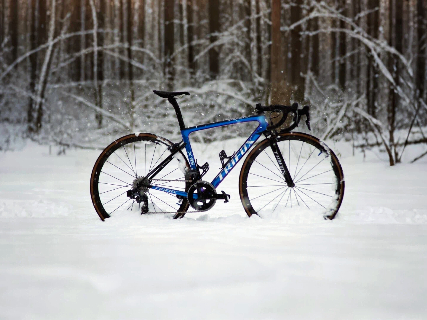
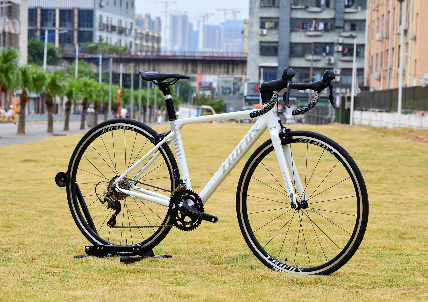
Finding the perfect balance between affordability and performance can be challenging for new road cyclists. The Trifox C-Brake Ultralight Aluminium Frame Road Bike strikes this balance beautifully, offering professional-level features at an accessible price point that's winning over beginners and experienced riders alike.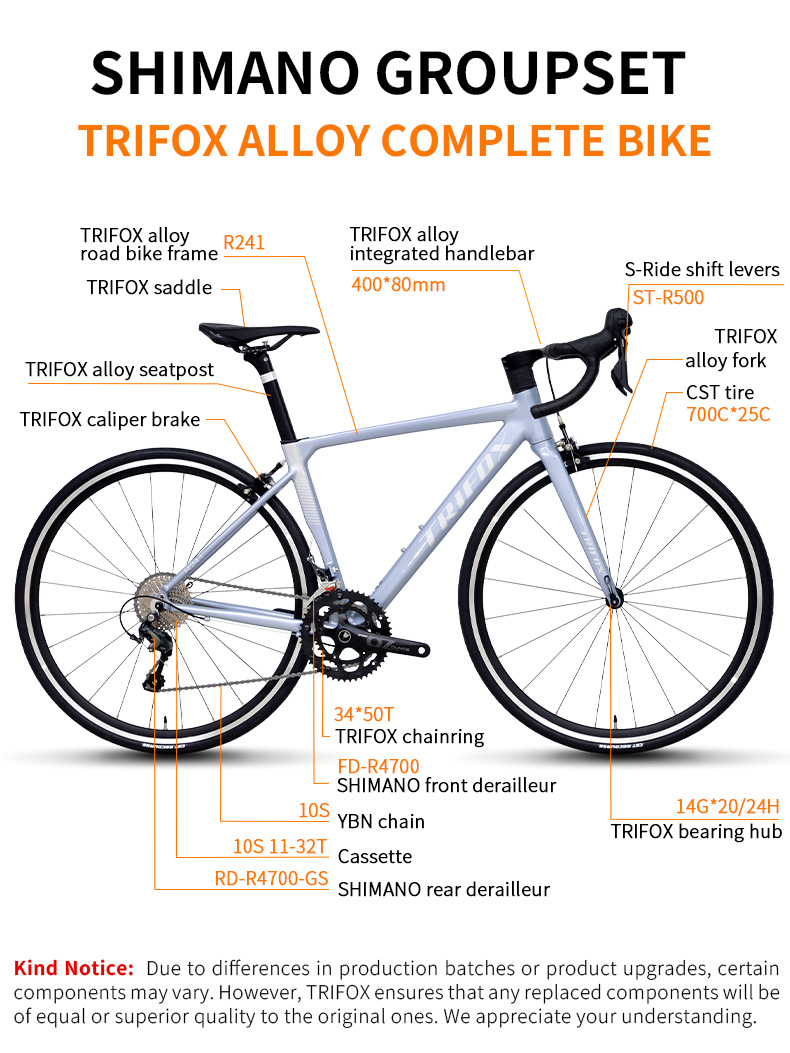
The Perfect Entry Point to Road Cycling
For those starting their cycling journey, this model stands out as one of the best entry level road bike options available. The lightweight aluminum frame provides the responsive ride quality that new cyclists seek, while the proven Shimano Tiagra groupset ensures reliable performance mile after mile. What makes this particular aluminum road bicycle special is its ability to deliver genuine road cycling excitement without the intimidating price tag of professional racing bikes.
Designed for Performance and Comfort
The frame geometry strikes an ideal balance between aggressive racing positions and comfortable endurance riding. This makes it an excellent choice as a ladies road bike, with sizing options that accommodate different body types and riding styles. The aero road bike inspired tube shaping not only looks fast but actually improves airflow around the bike, giving you an efficiency advantage whether you're keeping up with group rides or pushing for personal bests.
Quality Components That Matter
While some budget bikes cut corners on components, this alu road bike features a complete Shimano Tiagra 4700 2x10-speed groupset. The precise shifting and reliable braking performance give new riders the confidence to focus on developing their skills rather than fighting with their equipment. The combination of quality components and thoughtful frame design creates a racing bicycle experience that feels far more expensive than its actual price point.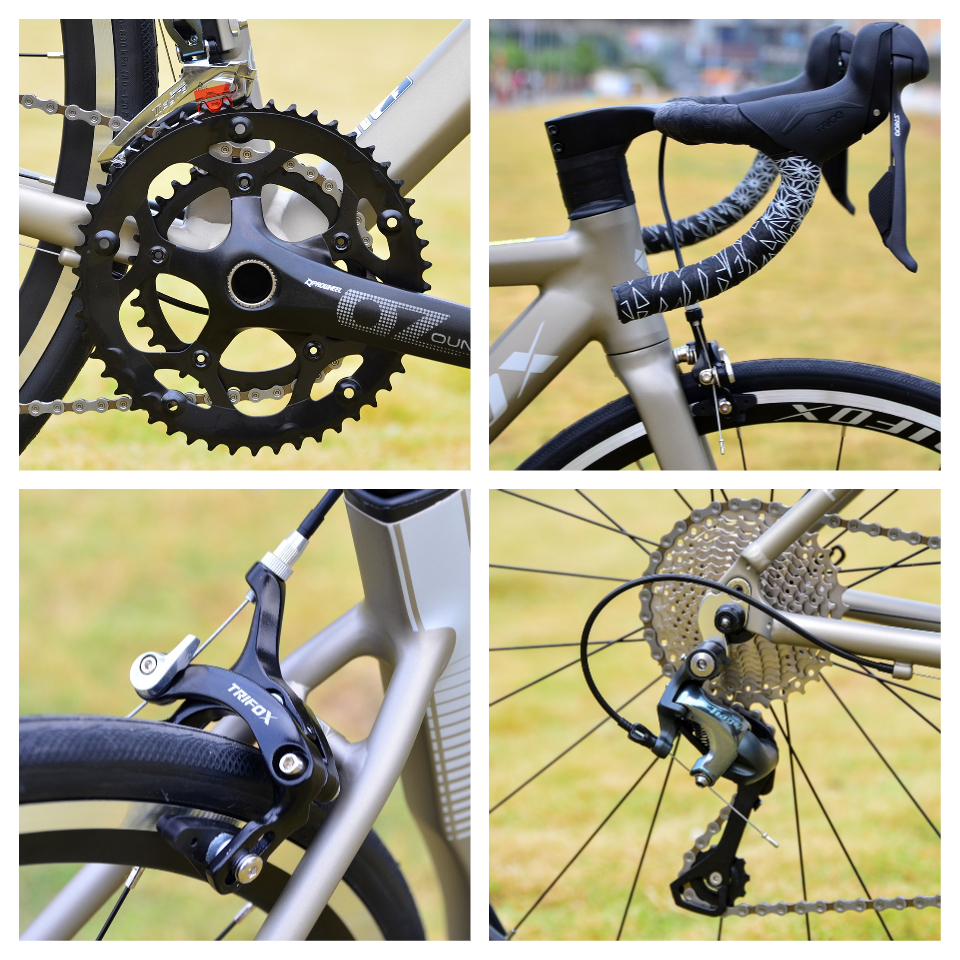
Versatility for Different Riding Styles
One of the bike's strongest advantages is its adaptability to various riding disciplines. The responsive nature of the aluminum road bicycle makes it equally suitable for fast club rides, endurance events, or even entry-level racing. The balanced geometry provides stable handling for beginners while still offering the quick reflexes that experienced riders appreciate when pushing the pace.
Exceptional Value in Modern Road Biking
In an era where carbon fiber often dominates the spotlight, this bike proves that advanced alu road bike technology continues to offer incredible value. The modern aluminum manufacturing techniques create frames that are both lightweight and durable, perfect for riders who want a low-maintenance bike they can rely on season after season.
The Smart Choice for Growing Cyclists
For riders who may eventually progress to more specialized bikes, this model serves as the perfect foundation. The quality construction means it will maintain its value, while the reliable performance ensures it can serve as a dedicated training bike or foul-weather companion down the road. It's not just a beginner bike - it's a smart investment in your cycling future that will continue to deliver enjoyment as your skills and fitness improve.
The Trifox Aluminum Road Bike represents everything that's right about modern entry-level cycling. By combining quality materials, proven components, and thoughtful design at an accessible price, it removes barriers to entry while still delivering the authentic road cycling experience that turns newcomers into lifelong enthusiasts.
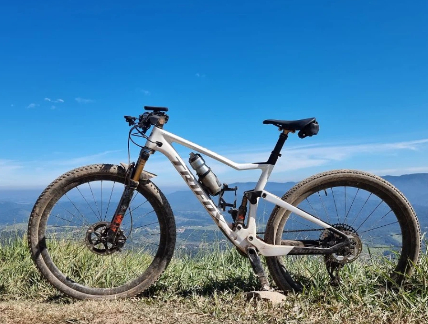
When it comes to conquering varied terrain, from steep technical climbs to flowing descents, having the right equipment makes all the difference. The Trifox 29er Carbon Full Suspension Trail Pioneer Bike represents the perfect balance of climbing efficiency and descending capability, making it an ideal choice for riders looking to master every aspect of trail riding.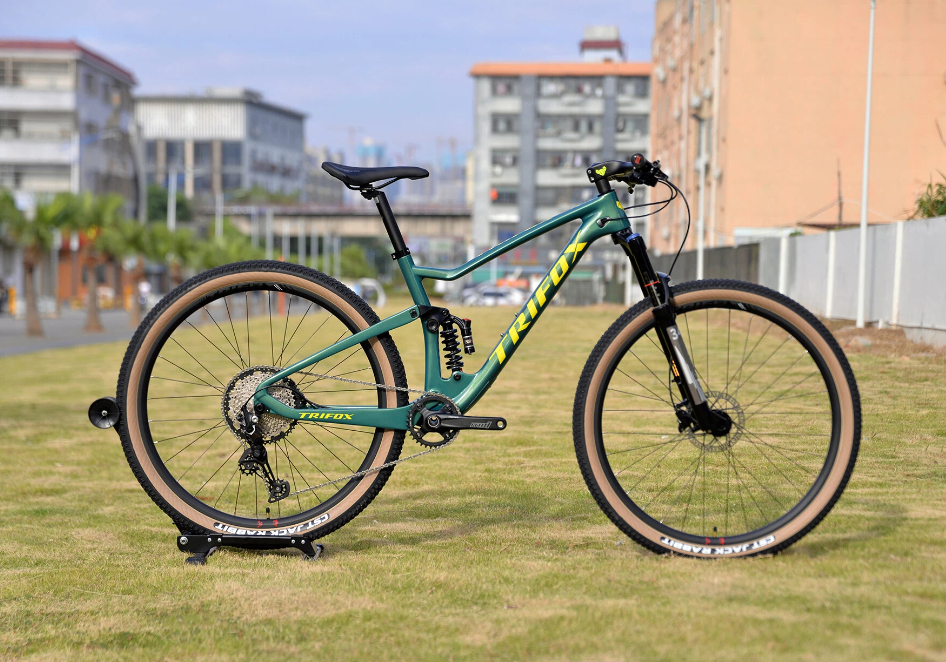
The Ultimate Trail Companion
A true full suspension trail bike needs to perform equally well going up as it does coming down. The Trifox Trail Pioneer excels in this regard, featuring a lightweight carbon frame that efficiently transfers power during climbs while the suspension system absorbs bumps and maintains traction. This combination makes it not just another mountain bike, but a genuine trail partner that enhances your riding experience regardless of the terrain.
Confidence-Inspiring Braking Performance
Modern trail riding demands reliable stopping power, and the mountain bike disc brakes on this bike deliver exactly that. Whether you're navigating technical rock gardens or carrying speed into bermed corners, the hydraulic disc brakes provide consistent modulation and power. This braking performance, combined with the bike's balanced geometry, gives riders the confidence to push their limits while maintaining full control.
Cross Country Performance Meets Trail Capability
While many bikes specialize in either climbing or descending, the Trifox Trail Pioneer truly bridges the gap between a pure cross country bike and a capable trail machine. The efficient pedaling platform and lightweight construction make it an excellent xc bike for covering long distances, while the generous suspension travel and modern geometry ensure it remains composed on challenging descents.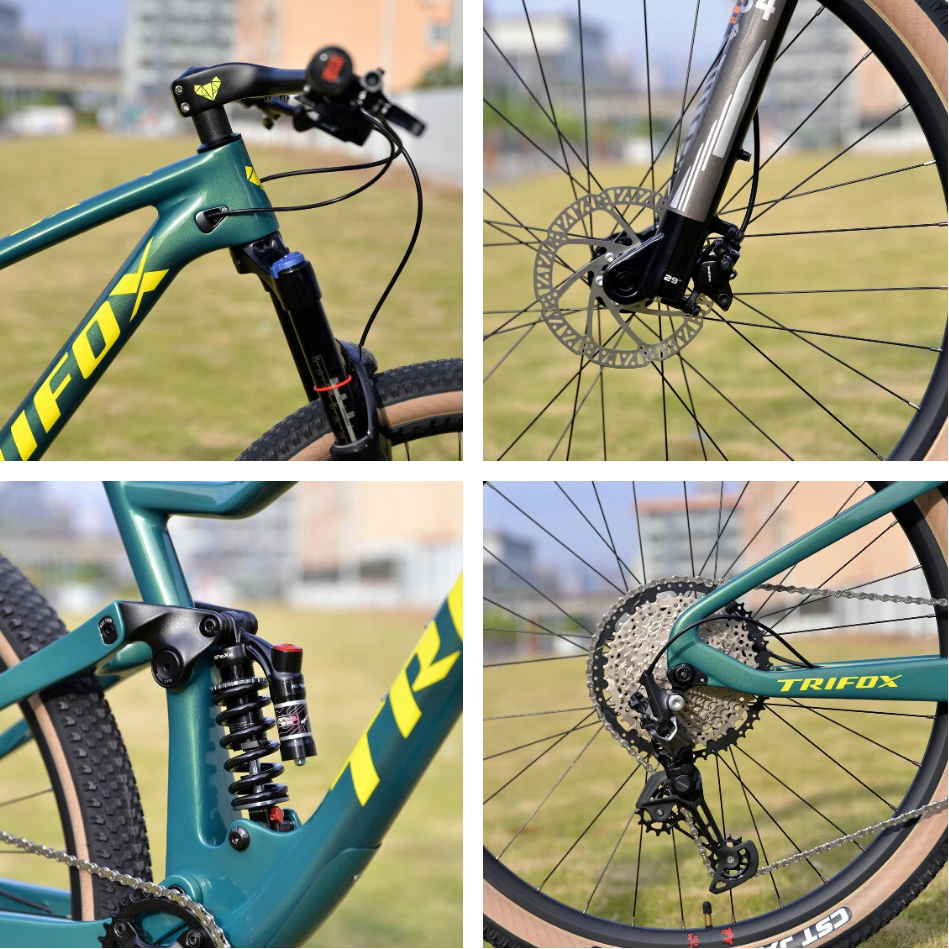
The 12-Speed Advantage
The inclusion of a 12-speed drivetrain significantly enhances the bike's capability across varying terrain. With a wider gear range than traditional systems, riders can tackle steep climbs without sacrificing top-end speed on flats and descents. The precise shifting and reliable performance of the 12-speed system ensure you're always in the right gear, whether you're grinding up a technical climb or accelerating out of corners.
Exceptional Value in Carbon Full-Suspension
Carbon full-suspension bikes often come with premium price tags, but the Trifox Trail Pioneer challenges this notion by offering what might be the cheapest full suspension mtb with genuine carbon construction and quality components. This accessibility means more riders can experience the benefits of a lightweight carbon frame and capable suspension without breaking the bank.
Ready for Whatever the Trail Throws at You
From rocky ascents that demand precise technical climbing to flowing descents where speed and control are paramount, this bike is designed to handle it all. The balanced suspension kinematics provide both pedaling efficiency and bump-eating compliance, while the carbon frame offers the perfect blend of stiffness and vibration damping. It's a bike that encourages progression and rewards skill development.
The Trifox 29er Carbon Full Suspension Trail Pioneer represents a new era of accessible high-performance mountain biking. By combining carbon construction, capable suspension, and modern components at an attractive price point, it removes barriers to entry for riders seeking to master all aspects of trail riding.
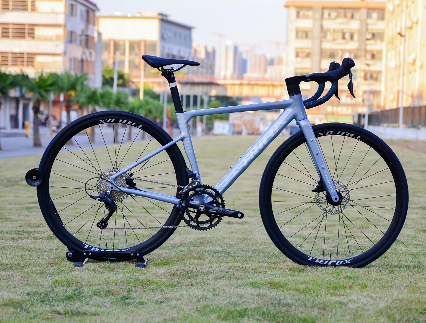
Stepping into the world of road cycling can be both exciting and overwhelming. With countless options available, choosing the right first bike becomes crucial to your cycling journey. The Trifox R241 700C Aluminium Frame Road Bike stands out as an exceptional choice, combining performance, reliability, and value in one package. Here's why a 22-speed disc brake aluminum road bike makes for the perfect first serious ride.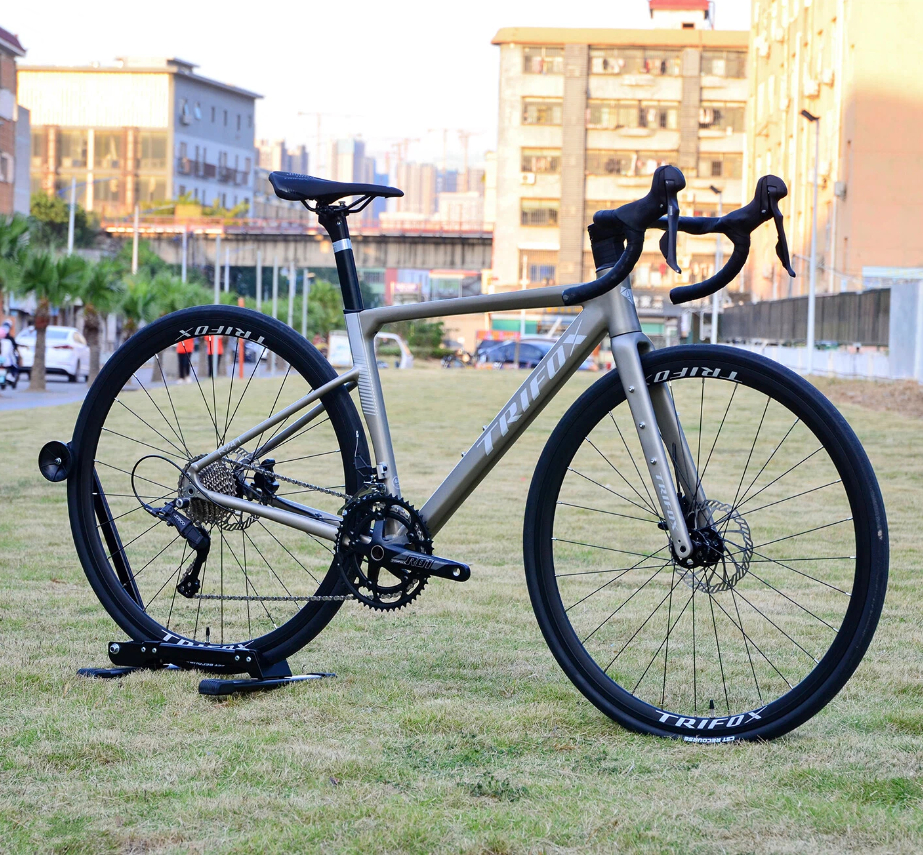
The Ideal Balance of Performance and Control
For beginners seeking their first serious road bike, the 22-speed drivetrain offers versatility across various terrains. Whether you're tackling steep hills or enjoying flat sprints, the wide gear range ensures you'll always have the right cadence. Paired with reliable disc brakes that provide consistent stopping power in all weather conditions, this setup builds confidence for new riders. The aluminum road bicycle frame delivers the perfect blend of durability and responsive handling, making it one of the good road bikes for beginners who want to progress quickly.
Why Aluminum Frames Make Excellent Starter Bikes
Aluminum frames have long been the go-to choice for entry-level and intermediate riders, and for good reason. The Trifox R241 features a lightweight aluminum frame that offers exceptional stiffness and power transfer. This means more of your pedaling effort translates into forward motion, giving you that authentic racing bicycle feel without the premium price tag. As an affordable road bike, it delivers performance characteristics that rival more expensive models, making it the best beginner road bike for those wanting to experience true road cycling performance.
Disc Brakes: Safety and Reliability for New Riders
One of the most significant advantages of this configuration is the inclusion of disc brakes. Unlike traditional rim brakes, disc brakes provide superior modulation and stopping power, especially in wet conditions. For beginners still developing their bike handling skills, this added safety margin is invaluable. The consistent performance of disc brakes allows new riders to focus on building technique and confidence rather than worrying about braking efficiency.
The Perfect Platform for Growth
What makes the Trifox R241 particularly special is its ability to grow with you as your skills develop. The quality aluminum frame serves as a solid foundation that can accommodate future upgrades, while the 22-speed gearing provides enough range to challenge you as you become stronger and more confident. It's not just a beginner bike - it's a platform that will support your progression in the sport.
Exceptional Value Without Compromise
In the world of road cycling, it's easy to spend thousands on a high-performance machine. However, the Trifox R241 demonstrates that you don't need to break the bank to get a quality ride. As one of the most affordable road bikes with premium features like a alloy 6061 fork and disc brakes, it offers tremendous value. The alloy fork specifically helps dampen road vibrations, adding comfort to your rides without sacrificing the responsive nature of an aluminum road bicycle.
Ready for Your Cycling Journey
Starting your road cycling adventure with the right equipment sets the tone for your entire experience. The 22-speed disc brake aluminum road bike represents the sweet spot for newcomers to the sport - capable enough to handle serious riding, forgiving enough to build confidence, and affordable enough to get you started without second thoughts. It's the best beginner road bike choice for those who are serious about developing their cycling skills while enjoying every mile.
The Trifox R241 combines all these elements into a package that's ready to roll. Whether you're looking to join group rides, tackle your first century, or simply enjoy the freedom of road cycling, this bike provides the perfect starting point for your journey on two wheels.
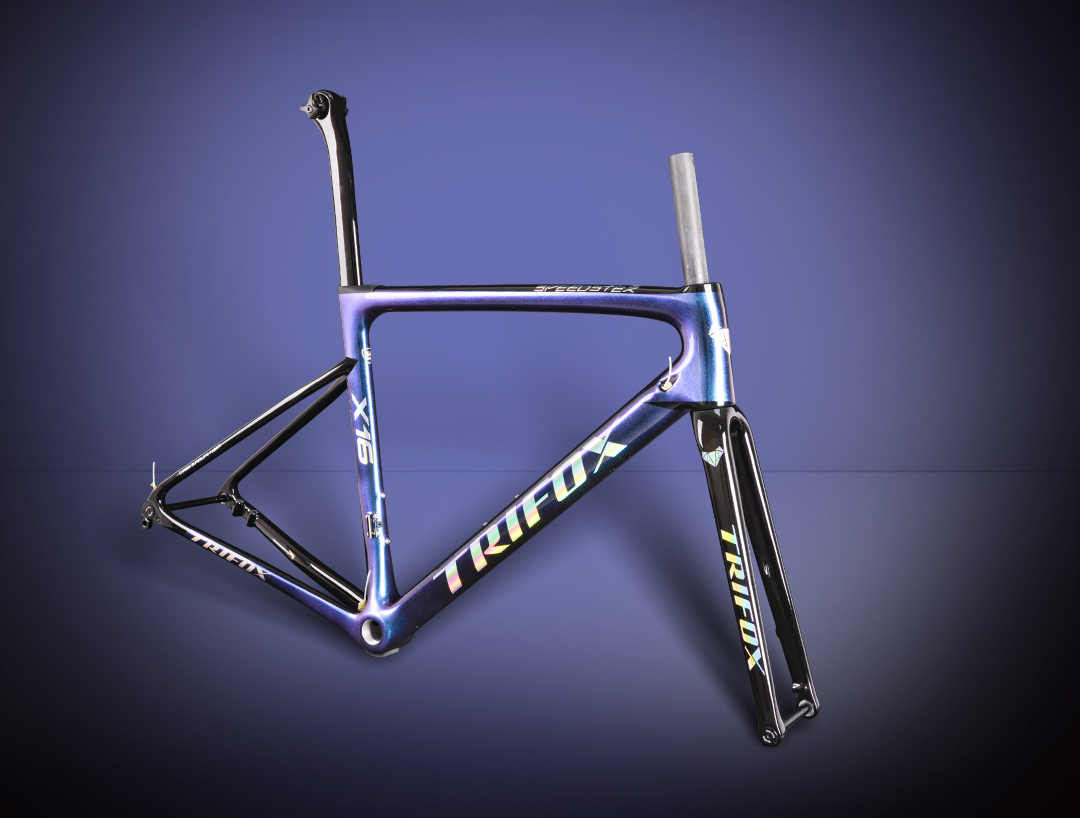
What makes a road bike frame truly popular? It's not just hype – it's the perfect blend of performance, value, and real-world usability. Trifox's X16 Disc Brake Carbon Frame consistently tops their charts, and for good reason. Let's dive into what makes this frame a standout choice for discerning riders:
Uncompromising Lightweight Performance: Crafted from high-modulus T800 carbon fiber, the X16 boasts an impressive frame weight hovering around 900g (size dependent). This translates directly to snappier acceleration, effortless climbing, and a lively, responsive ride that feels eager under power. It's pure road buzz without the penalty.
Disc Brake Dominance: Embracing the modern standard, the X16 features flat-mount disc brake compatibility. This means superior stopping power in all conditions – wet descents, tight corners, or emergency stops – offering consistent modulation and control that rim brakes simply can't match. Confidence is key to speed.
Stiffness Meets Comfort: Trifox engineers didn't just chase grams. The X16 features a stiff front triangle (head tube, down tube, bottom bracket) for razor-sharp handling and efficient power transfer when you stomp on the pedals. Yet, the carefully shaped thin seatstays and fork provide crucial vertical compliance, absorbing road buzz and reducing fatigue on longer rides. You get race-ready feedback without the harshness.
Modern, Versatile Geometry: The X16 strikes a brilliant balance. Its geometry leans towards aggressive (think shorter headtubes, longer reaches) for efficient power output and aerodynamic potential, yet remains accessible enough for spirited club rides and gran fondos. It’s a frame built for speed that doesn’t demand a pro-level contortion.
Smart, Rider-Focused Design:
Threaded Bottom Bracket (BB86): A massive win for reliability and home mechanics. No press-fit creaks here! Easy installation and long-term peace of mind.
Full Internal Cable Routing: Creates a sleek, aerodynamic profile while protecting cables and hoses from the elements. Looks pro, functions flawlessly.
Wide Compatibility: Accommodates electronic and mechanical groupsets, 28c+ tires (great for comfort/rough roads), and standard 27.2mm seatposts for tuning ride feel.
Why the X16 Resonates:
It delivers pro-level pedigree (lightweight carbon, advanced shaping, disc performance) at a direct-to-consumer price that makes high-performance cycling genuinely accessible. You're not paying for flashy marketing or dealer markups – just exceptional engineering focused on the ride.

The Trifox X16 isn't just popular; it's popular for a reason. It masterfully combines the essential ingredients modern road riders crave: lightweight carbon efficiency, the confidence of disc brakes, a balanced blend of stiffness and comfort, and practical, reliable design – all wrapped up in a package offering outstanding value. If you're seeking a frame that punches far above its weight class and forms the foundation of a truly exciting road machine, the X16 is Trifox's testament to smart performance.
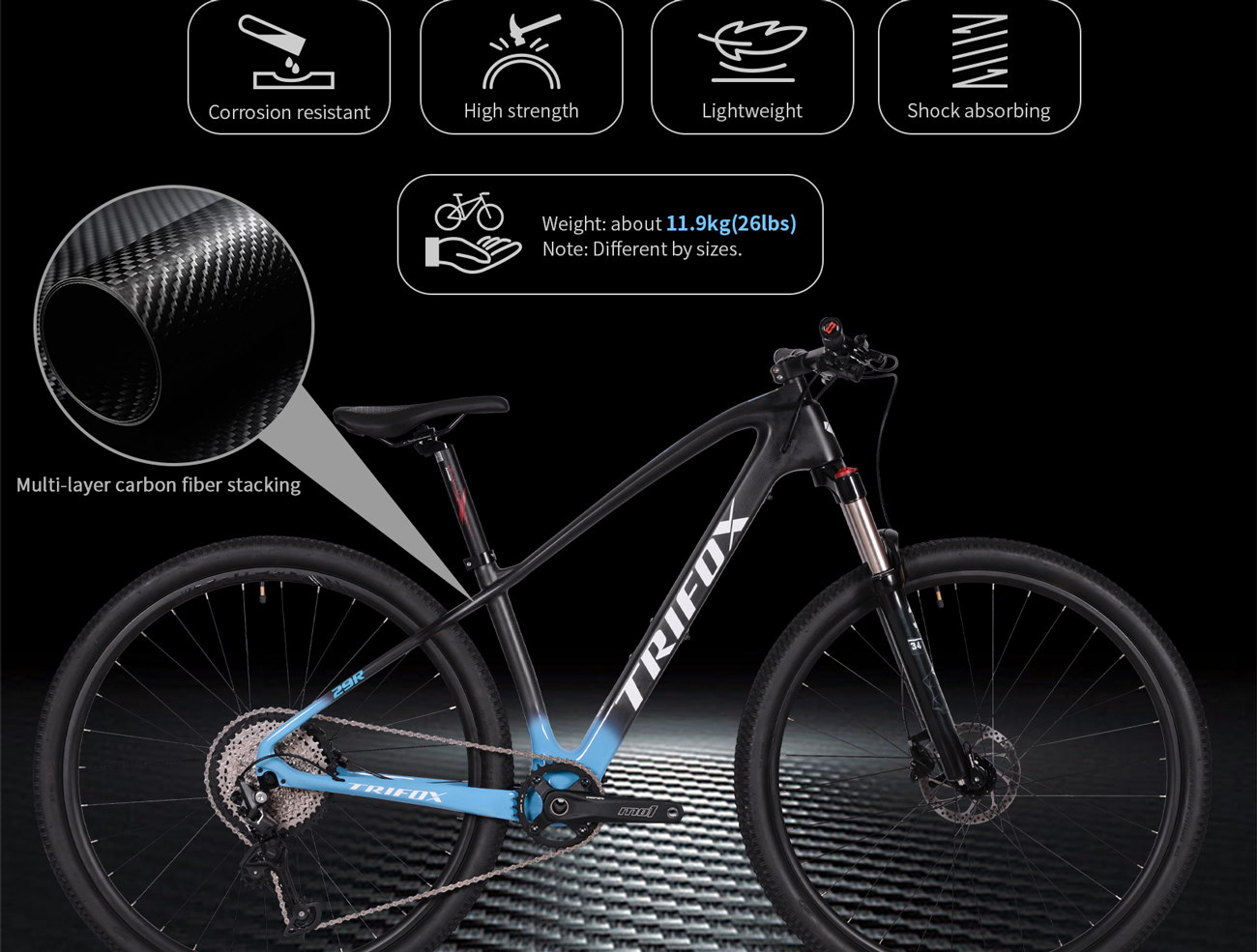
Think building a capable, lightweight hardtail requires breaking the bank? Think again. The sub-$250 frame market is hotter than ever, offering surprising performance for riders seeking value without sacrificing fun. We scrutinized options, and one standout shines: the Trifox MFM200 Carbon Hardtail Frame. Here’s why it’s a budget hero:
The Carbon Game-Changer (Yes, at $227!)
The MFM200 shatters expectations by delivering a full carbon fiber frame at an astonishing price point. Forget heavy steel or flexy aluminum – this frame offers the core benefits of carbon:
Ultralight Build: Weighing in around 1200g (size dependent), it sheds serious pounds compared to alloy frames at this price. That translates directly to easier climbing and a livelier, more responsive feel on every trail.
Stiffness for Speed: Carbon construction ensures excellent pedaling efficiency. Power transfer is direct, minimizing wasted energy when you stomp on the pedals, whether sprinting or grinding uphill.
Tuned Trail Compliance: While stiff laterally, carbon can offer subtle vertical flex. The MFM200’s design helps absorb smaller bumps and chatter, reducing fatigue on longer rides and rough sections, making it more capable than its price suggests.
Modern Geometry for Real Trails
Trifox didn't skimp on contemporary design:
Slack Head Tube Angle (~66-67°): Boosts confidence on descents, improving stability when things get steep or rough.
Steep Seat Tube Angle (~74-75°): Positions you efficiently over the pedals for better climbing traction and comfort.
Reach & Wheelbase: Balanced numbers provide a stable yet maneuverable ride suitable for aggressive trail riding and XC adventures.
Smart Build Compatibility
The MFM200 plays nice with widely available, affordable components:
Boost Hub Spacing (148x12mm rear): Ensures stiffness and compatibility with modern wheelsets.
Internal Cable Routing: Clean looks and protection for dropper posts and derailleurs.
Tapered Headtube: Fits modern, stiff forks for precise steering.
Threaded Bottom Bracket: A huge win for reliability and ease of maintenance – no creaky press-fits!
Value Verdict: The Trifox MFM200
Finding a new carbon frame under $230 feels almost unreal. The Trifox MFM200 delivers the core advantages of carbon – significant weight savings, efficient power transfer, and surprisingly good trail manners – wrapped in modern, capable geometry. While you might find minor finish differences compared to premium frames, the fundamental performance is undeniable.
Is it perfect? Consider:
Finish: Expect functional over flawless – cosmetics might be simpler.
Hardware: Bearings and bolts are adequate, but upgrading later is easy.
Build Cost: Remember, the frame is just the start! Factor in fork, drivetrain, wheels, etc.
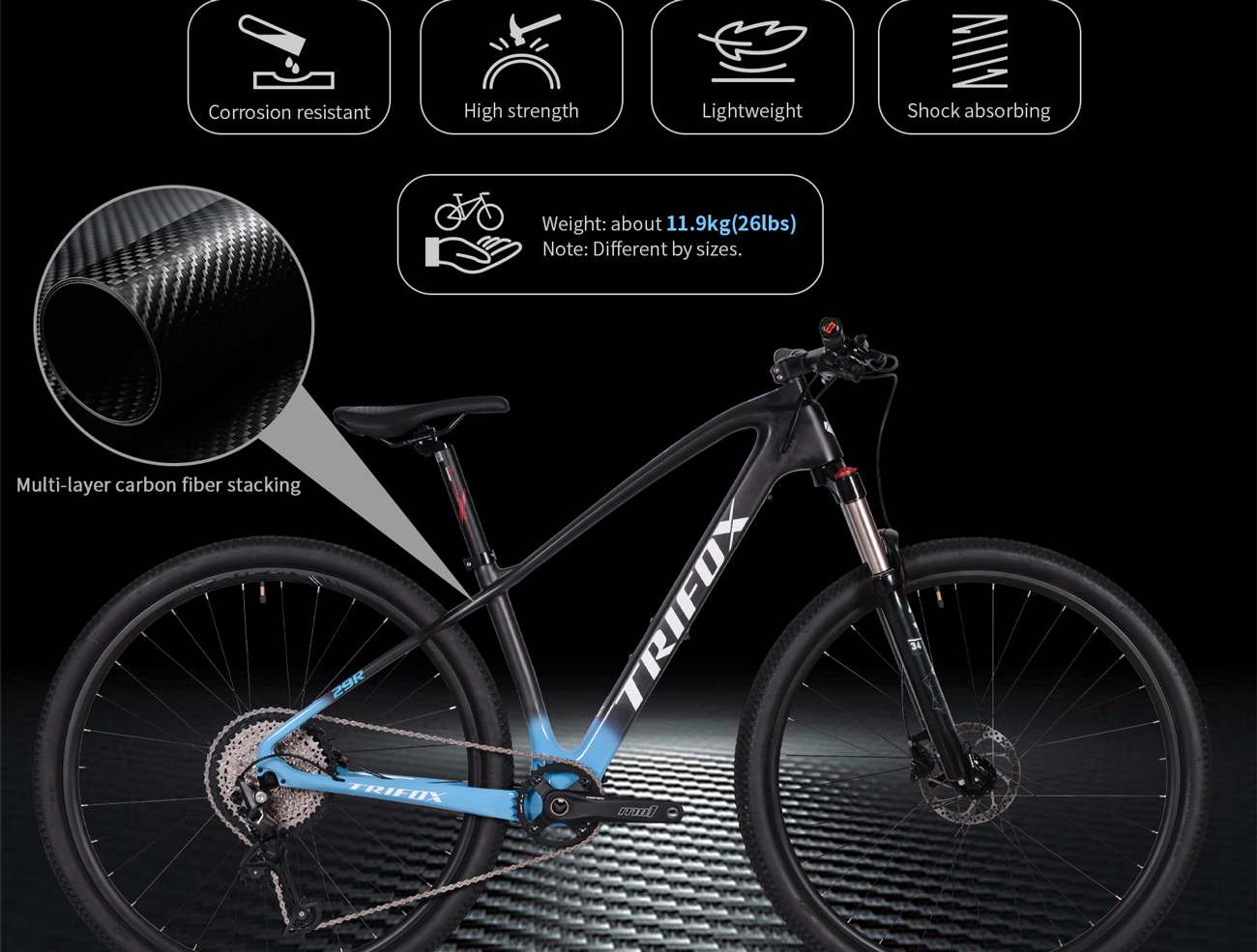
The Bottom Line:
For riders demanding a lightweight, efficient, and modern hardtail platform without blowing the budget, the Trifox MFM200 is a revelation. It proves you don't need $1000+ to get a frame that unlocks hardtail heroics. Pair it with smart component choices, and you’ve got a trail-taming machine that punches way above its weight class. Budget hardtails just leveled up!

Remember when carbon fiber was reserved for pro pelotons and deep-pocketed racers? Not anymore. Mountain biking is witnessing the unstoppable rise of carbon, transforming trails from XC loops to gnarly enduro descents. Brands like Trifox are making this once-exotic material accessible, proving carbon MTBs aren't just lighter – they're better riding machines. Here's why the shift is seismic:
Featherweight Flight: This is the headline. Carbon frames slash pounds off alloy counterparts. Less weight means easier climbing, quicker acceleration, and less fatigue over long days. You carry the bike less; the bike carries you more. Trifox's carbon hardtails and full-suspension rigs exemplify this advantage, turning arduous ascents into achievable efforts.
Stiffness Meets Sensation: Carbon isn't just light; it's incredibly tuneable. Engineers craft frames with targeted stiffness where it matters most: the bottom bracket for efficient pedaling, the head tube for precise steering. Yet, carbon's magic lies in its ability to also offer vertical compliance. It absorbs smaller trail chatter better than alloy, reducing arm and leg fatigue, letting you ride harder, longer.
Strength You Can Trust: Forget the "fragile" myth. Modern carbon layups create structures incredibly resistant to impacts and fatigue. When designed correctly (like Trifox's robust mountain frames), carbon handles rock strikes, drops, and rough terrain with impressive resilience. It won't dent like aluminum and shrugs off corrosion.
Ride Refined: The combination of lightness, stiffness, and subtle flex translates to a more connected, responsive, and lively feel. You feel the trail without being beaten by it. Carbon bikes track better through corners, feel more nimble in the air, and offer a directness that boosts confidence when pushing limits.

Trifox: Bringing Carbon to the Trail
Brands like Trifox are crucial to this rise. By leveraging efficient manufacturing and direct-to-consumer models, they deliver high-performance carbon mountain bikes at astonishingly competitive prices. Whether it's their agile carbon hardtails perfect for XC and trail blasting, or their capable full-suspension platforms, Trifox proves you don't need a pro contract to experience the carbon revolution.
The Verdict: Not Just a Trend, The Future
The rise of carbon fiber in mountain biking isn't just hype; it's a fundamental shift driven by tangible performance benefits. It offers a superior blend of weight, strength, stiffness, and ride quality that alloy struggles to match. As manufacturing advances and brands like Trifox make it more accessible, carbon is becoming the material of choice for riders seeking every advantage on the trail. It’s not about replacing alloy entirely, but about offering a compelling, high-performance option that’s redefining what’s possible on two wheels. Ready to feel the difference? Explore the carbon evolution: Discover Trifox Mountain Bikes.
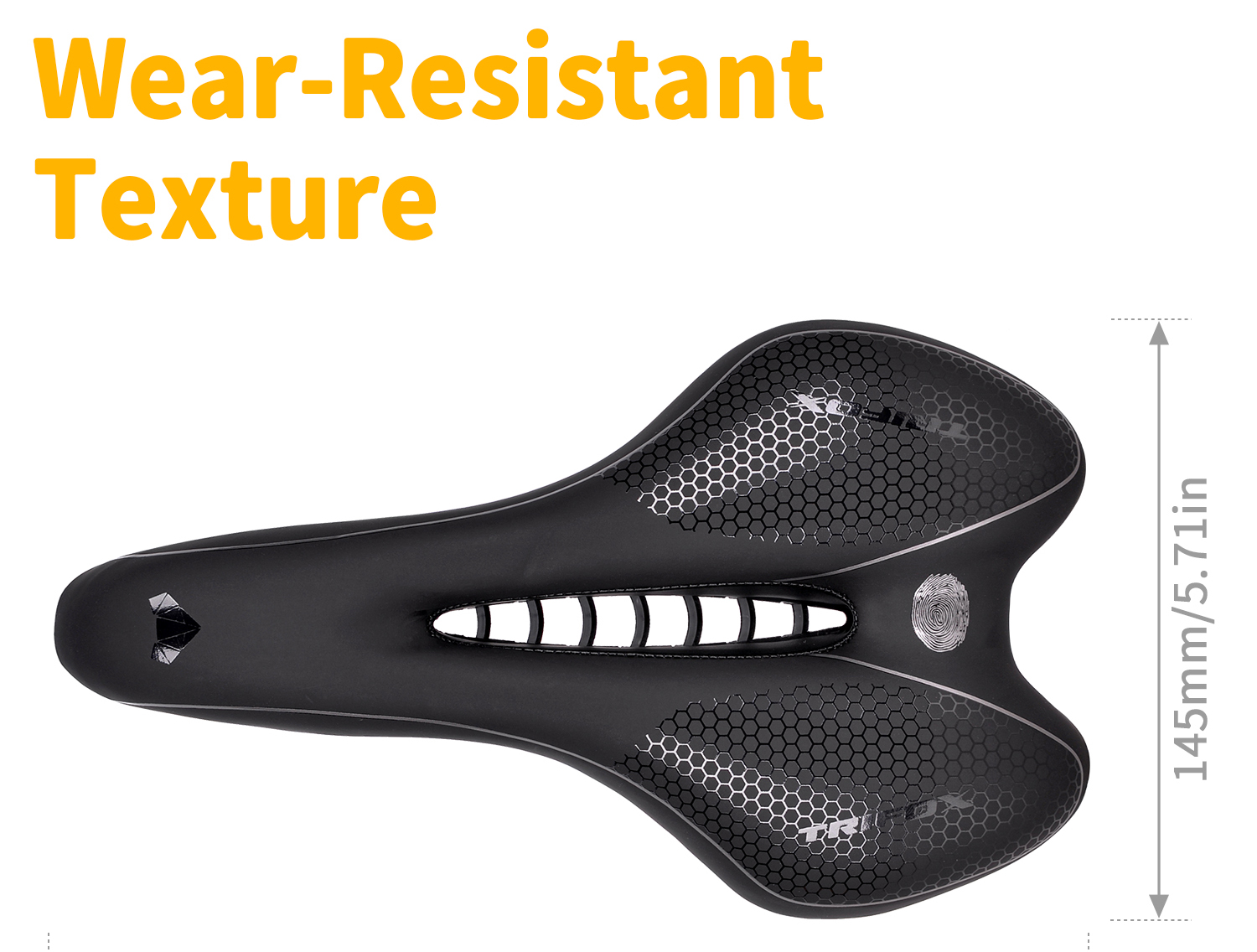
That stock saddle on your road bike? It served its purpose getting you started. But if you're chasing performance, comfort, or simply a more refined ride, upgrading to a full-carbon saddle like the Trifox CS200 is a game-changer. Forget the misconception that carbon is harsh – modern designs blend featherweight efficiency with surprising comfort. Here's why the switch is worth it:
1. The Weight Weenie Wins: This is the obvious one. At a claimed 120 grams, the Trifox CS200 utterly demolishes typical alloy-railed saddles (often 250g+). Shedding 100+ grams directly off your bike, especially high up and at the contact points, makes a tangible difference. It's pure acceleration, easier climbing, and the satisfaction of marginal gains realized. Every watt feels more efficient.
2. Stiffness = Power Transfer: Carbon fiber's inherent stiffness isn't just for weight savings. It means virtually zero flex under power. When you stomp on the pedals, every ounce of energy goes into propelling you forward, not lost compressing padding or flexing the shell. You'll feel a more direct, connected drive, especially during sprints and out-of-the-saddle efforts.
3. Engineered Comfort (Yes, Really!): "Carbon must be hard!" is the biggest myth. Saddles like the CS200 use carefully sculpted shapes, strategic flex zones in the carbon base, and minimal high-density padding precisely where needed. This provides targeted support to your sit bones, reducing pressure on soft tissue. Less padding can actually mean less numbness on long rides, as your weight is correctly distributed. The shape is key, and many find carbon shells conform better over time.
4. Breathability Matters: Ever finished a long ride feeling swampy? Full-carbon bases are inherently perforated or designed with significant cutouts/channels (like the CS200). This promotes airflow, drastically reducing heat and moisture buildup. Enhanced ventilation equals greater comfort and reduced friction, ride after ride.
5. Durability & Low Maintenance: Carbon fiber is incredibly resilient to fatigue and corrosion. Unlike leather or synthetic covers that can degrade, or rails that can rust, a quality carbon saddle shrugs off sweat, weather, and miles. It requires minimal upkeep beyond wiping clean.
The Trifox CS200: A Prime Example
The Trifox CS200 exemplifies these benefits perfectly:
- Ultralight 120g: Significant weight savings.
- Full Carbon Shell & Rails: Maximizes stiffness and durability while minimizing weight.
- Strategic Padding: Minimal, high-rebound foam for targeted comfort without bulk.
- Central Cutout: Enhances breathability and relieves perineal pressure.
- Aerodynamic Shape: Sleek design complements a performance road bike.
Is it for Everyone?
Like any saddle, fit is paramount. A carbon saddle's shape needs to match your anatomy. If the stock shape works for you, upgrading to carbon refines it. If not, focus on finding the right shape first, then consider carbon for the performance benefits. The Trifox CS200 offers a popular, performance-oriented profile.
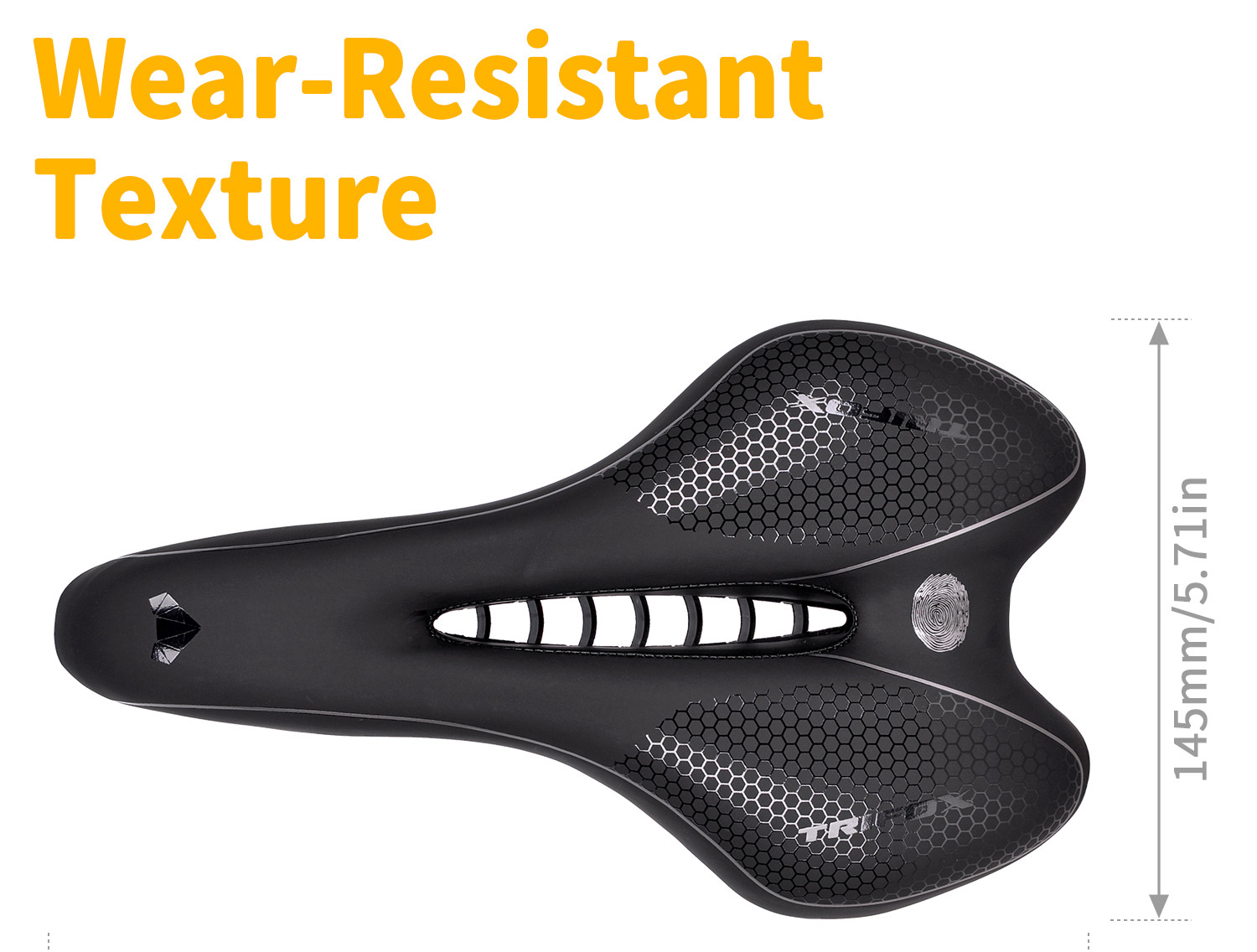
The Upgrade Verdict:
Upgrading to a carbon saddle isn't just about shaving grams; it's about enhancing the fundamental connection between you and your bike. The blend of dramatic weight reduction, efficient power transfer, surprising comfort through intelligent design, and superior breathability creates a noticeably better riding experience. If you're ready to feel more connected, efficient, and comfortable, especially on demanding rides, a saddle like the Trifox CS200 is a worthy investment. It transforms a crucial contact point from a necessary component into a performance asset. Make the switch and feel the difference!
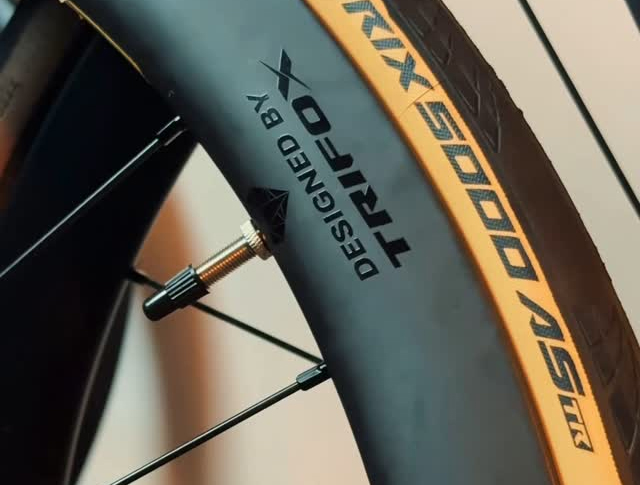
Forget "just" improved stopping power – switching to a dedicated disc brake wheelset unlocks a cascade of performance benefits that fundamentally elevate your road riding. It's not an incremental upgrade; it's a transformation in control, confidence, and capability.
Why Disc Wheelsets Rule the Road:
1. Unshakeable Confidence, Anywhere, Anytime: Rim brakes falter in wet grit or on long, steep descents. Discs deliver consistent, powerful, and modulated braking performance regardless of weather, road grime, or gradient. This translates directly to riding faster with more control when it matters most.
2. Aerodynamic & Structural Advantages: Free from the need for a braking surface, disc wheelsets allow for wider, deeper, and more aerodynamically optimized rim profiles. This reduces drag for free speed. The rim itself is also stronger without the wear surface, enabling lighter constructions and improved impact resistance.
3. Tubeless Paradise: Disc wheelsets are the perfect partners for tubeless tires. Wider rims create a better tire profile for lower rolling resistance, enhanced grip, and the holy grail: fewer flats at lower pressures. No more worrying about brake track wear from heat during hard descents either.
4. Future-Proof Performance: The industry standard is clear. Disc brakes dominate new road bikes. Investing in a quality disc wheelset ensures compatibility with the latest frames and groupsets, protecting your upgrade path.
The Trifox WT11: Performance Engineered for Disc:
The WT11 Disc Brake Centerlock Clincher Carbon Wheelset embodies these advantages:
- Lightweight Carbon Construction: Prioritizes acceleration and climbing response.
- Optimized Aero Depth: Balances speed and crosswind stability.
- Wider Rim Profile: Enhances tire performance and supports tubeless setups seamlessly (valves included!).
- Reliable Centerlock Interface: Ensures secure rotor mounting and easier maintenance.
- Stiffness & Durability: Engineered for powerful sprints and demanding riding.
Who Wins with Disc Wheels?
- All-Weather Warriors: Ride confidently rain or shine.
- Descenders & Climbers: Brake later, descend faster, climb without rim heat worries.
- Speed Seekers: Leverage superior aero and tubeless efficiency.
- Tech Adopters: Invest in the modern standard.
Ready for Uncompromised Control & Speed?
Upgrade your stopping power, unlock aerodynamic gains, embrace tubeless simplicity, and future-proof your ride. Disc wheelsets aren't just better brakes; they're the foundation for a faster, safer, and more enjoyable road experience.

























































